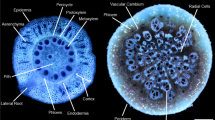Abstract
Three hundred nineteen accessions of 59 tuber bearing species ofSolanum were screened for heat tolerance. The ability to produce shoot growth at high temperature (30 to 40 C) was tested initially. Since shoot growth is affected by tuberization, plants were grown at 18-h photoperiods to minimize tuber induction in all accessions. Fifty-one accessions of seven species were screened in three separate years to assess the stability of the estimates of heat tolerance. Shoot fresh weights at the high temperature were significantly correlated (r=0.7) from year to year, as were ratings for plant vigor at the high temperature (r=0.5).
Accessions that showed good shoot growth at the high temperature were screened again for tuberization under short days and high temperature (30 to 40 C). In general, tuberization was highly variable, but a few species and a few accessions showed consistent tuberization at 30 to 40 C.
Compendio
Se tamizaron 319 entradas de especies deSolanum formadoras de tubérculo, para tolerancia al calor. Inicialmente se probó la habilidad de generar el desarrollo de brotes a altas temperaturas. Desde que el desarrollo de brotes es afectado por la tuberización, las plantas se dejaron crecer a fotoperiodos de 18 horas para minimizar la inducción de formación de tubérculos en todas las entradas. Se tamizaron 51 entradas de siete especies, en tres años separados, para evaluar la estabilidad de los estimados de tolerancia al calor. Hubo una correlación significativa (r=0.7) de año a año en el peso fresco de los brotes a temperatura alta, así como también en los valores para vigor de la planta a temperatura alta (r=0.5).
Las entradas que mostraron un buen desarrollo a temperatura alta se tamizaron nuevamente para tuberización bajo condiciones de día corto y temperatura alta (30–40 C). En general, la tuberización fué altamente variable, pero unas pocas especies y unas pocas entradas mostraron tuberización consistente entre 30 y 40 C.
Similar content being viewed by others
Literature Cited
Ben Khedher, M. and E.E. Ewing. 1985. Growth analysis of eleven potato cultivars grown in the greenhouse under long photoperiods with and without heat stress. Am Potato J 62:537–554.
Bodlaender, K.B.A. 1963. Influence of temperature, radiation and photoperiod on development and yield.In: J.D. Ivins and E.L. Milthorpe (eds.). The growth of the potato. Butterworths, London. pp. 199–210.
Boodley, J.W. and R. Sheldrake, Jr. 1973. Cornell peatlite mixes for commercial plant growing. Cornell Univ. Inform. Bull. 43. 8 pp.
Burton, W.G. 1972. The response of potato plant and tuber to temperature.In: A.R. Rees, K.E. Cockshull, D.W. Hand, and R.G. Hurd (eds.). Crop processes in controlled environments. Proc. of an Inter. Symp., Glasshouse Crops Res. Inst., Littlehampton. Academic Press, London and New York. pp. 217–233.
Burton, W.G. 1981. Challenges for stress physiology in potato. Am Potato J 58:3–14.
Driver, C.M. and J.G. Hawkes. 1943. Photoperiodism in the potato. Imp. Bur. Plant Breed. Genet., Tech. Comm. 36 pp.
Ewing, E.E. 1985. Cuttings as simplified models of the potato plant.In: P.H. Li (ed.). Potato Physiology. Academic Press, London. pp. 153–207.
Ewing, E.E. and E.R. Keller. 1983. Limiting factors to the extension of the potato into non-traditional climates.In: W. J. Hooker (ed.). Proceedings of the International Congress in Celebration of the Tenth Anniversary of the International Potato Center. International Potato Center, Lima. pp. 22–27.
Ewing, E.E., J.H. Lorenzen, M.P. Reynolds, S. Gebre-Mariam, R.G. Snyder and M. Ben Khedher. 1987. Evaluating heat tolerance in potato.In: W.N. Chang, P.W. MacGregor, and J. Bay-Peterson (eds.). Improved Vegetable Production in Asia. Food and Fertilizer Technology Center, Taipei. Book Series No. 36. pp. 110–118.
Gregory, L.E. 1965. Physiology of tuberization in plants, (Tubers and tuberous roots).In: W. Rhyland (ed.). Handbuch der Pflanzenphysiologie, Vol. 15, Part 1. Springer Verlag, Berlin, Heidelberg, New York. pp. 1328–54.
Hanneman, R.E., Jr. and J.B. Bamberg. 1986. Inventory of tuber-bearingSolanum species. Wis. Agri. Exper. Sta. Bull. 533. 215 pp.
Kahn, B.A., E.E. Ewing, and A.H. Senesac. 1983. Effects of leaf age, leaf area, and other factors on tuberization of cuttings from induced potato (Solanum tuberosum) shoots. Can J Bot 61:3193–3201.
Marinus, J. and K.B.A. Bodlaender. 1975. Response of some potato varieties to temperature. Potato Res 18:189–204.
Midmore, D.J. and Mendoza, H.A. 1984. Improving adaptation of the potato (Solanum spp.) to hot climates—some physiological considerations.In: F.S. Shideler and H. Rincón (eds.). Proceedings of the Sixth Symposium of the International Society for Tropical Root Crops. International Potato Center, Lima. pp. 457–464.
Plaisted, R.L. and R.W. Hoopes. (In Press) The past record and future prospets for the use of exotic potato germplasm. Am Potato J.
Reynolds, M.P. and E.E.Ewing. (In Press) Effects of high air and soil temperature stress on growth and tuberization inSolanum tuberosum L. Ann Bot.
Reynolds, M.P., E.E. Ewing, and T.G. Owens. 1987. Heat tolerance in wild potato species: Its relationship with photosynthetic capacity and leaf age. Hortscience 22:1106. (Abstr.)
Simmonds, N.W. 1971. The potential of potatoes in the tropics. Trop. Agri, Trinidad 48:291–299.
Swaminathan, M.S. and R.L. Sawyer. 1983. The potential of potato as a world food.In: W.J. Hooker (ed.). Proceedings of the International Congress in Celebration of the Tenth Anniversary of the International Potato Center. International Potato Center, Lima. pp. 3–4.
Van der Plank, J.E. 1947. Some climatic factors determining high yields of potatoes. II. The potato at low altitudes and high altitudes. J Exper Agri 15:1–8.
Van der Zaag, D.E. 1984. Reliability and significance of a simple method of estimating the potential yield of the potato crop. Potato Res 27:51–53.
Author information
Authors and Affiliations
Additional information
Paper No. 866, Department of Vegetable Crops, Cornell University.
Rights and permissions
About this article
Cite this article
Reynolds, M.P., Ewing, E.E. Heat tolerance in tuber bearingSolanum species: A protocol for screening. American Potato Journal 66, 63–74 (1989). https://doi.org/10.1007/BF02854425
Accepted:
Issue Date:
DOI: https://doi.org/10.1007/BF02854425



